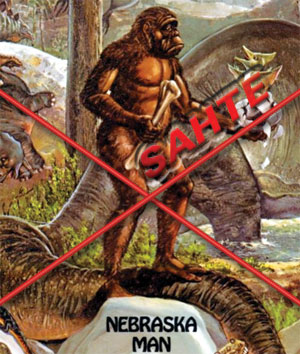  |
| Darwinists went even further and depictefd the fictitious entity they named Nebraska Man, on the basis of a single pig tooth, together with his family. |
The subject of human evolution is of vital importance to Darwinists. The idea they have tried for years to indoctrinate people with is the lie that man is a supposed evolved animal. They strive with all their power to maintain this lie, and attempt to insert the idea that human beings have supposed animal ancestors in even the most unrelated subjects. The deceptions to which they resort on this matter are breathtaking. Even totally unconnected fossil find is presented in such a way as to suggest they are human beings. So much so that Darwinists produced Nebraska Man from a single fossil tooth, which would later be proven to belong to a wild pig, and they had no qualms about depicting this entity's entire social life together with its family and community. One of the most significant examples of these astonishing endeavors is their long-time claim that Australopithecus is the so-called ape-like ancestor of man.
Australopithecus is an extinct species of ape. The name means "Southern ape," and Darwinists seek to depict it as the first ape-like ancestor of human beings. As with all other examples, since this species of ape is extinct, evolutionists have used it as a tool for speculation. But as with all other examples, the scenarios that Darwinists produce regarding Australopithecus are again based on deception.
Australopithecus is thought to have first appeared in Africa fourmillion years ago and to have survived until one million years ago. The fact that needs to be made absolutely clarified here is that all Australopithecines are extinct apes resembling their modern-day counterparts. They all have brain volumes the same as, or smaller than those of present-day chimpanzees. They walked on four feet. Like present-day apes they had bony protrusions that helped them to climb trees, and their feet were prehensile to allow them to cling onto branches. They were short in stature (maximum 130 centimeters) and, just like present-day apes, the male Australopithecus was much larger than the female. Hundreds of details in their skulls, and features such as their close-set eyes, their sharp molars, their jaw structure and their long arms and short legs are all evidence showing they were no different to present-day apes.
Australopithecus - Resemblance to a Chimpanzee | |
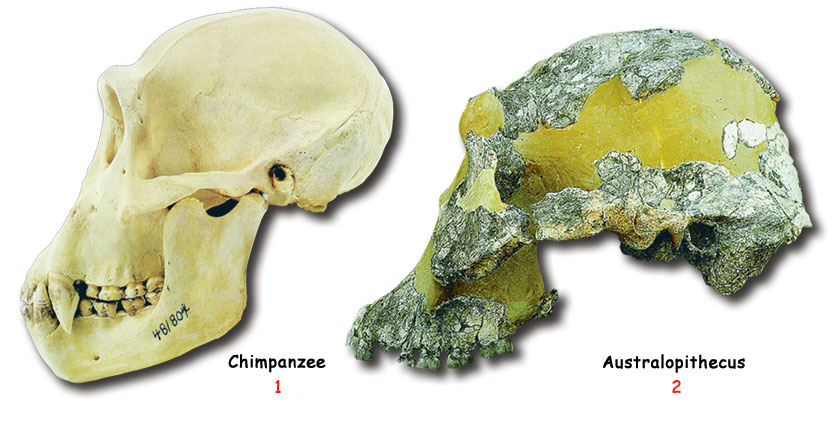 | |
| 1. Chimpanzee | 2. Australopithecus |
| The similarity between Australopithecus and chimpanzee skulls indicates that Australopithecus is a genuine species of ape, rather than an ancestor of man. | |
Although the Australopithecines were all evidently species of ape, Darwinists describe them as life forms that managed to walk on two legs. This is a blatant deception, because not a single one of the Australopithecus-related fossils unearthed to date corroborates this scenario. The evolutionary scenario for these entities is thus based on no scientific evidence.
According to Darwinists, although there were various species in the Australopithecus family, only Australopithecus afarensis (the species represented by "Lucy", who was portrayed to the whole world as proof of so-called human evolution when she was discovered in 1974) is regarded as a direct ancestor of man. However even Darwinists have accepted that the creature in question cannot be put forward as the ancestor of humans. The French Darwinist journal Science et Vie used the subject as its cover story in its May 1999 issue. Under the caption "Adieu Lucy," the magazine discussed Lucy, regarded as the most important fossil specimen from the species Australopithecus afarensis, and said that Australopithecus apes were not the forerunners of human beings, and that they should be removed from the family tree.67
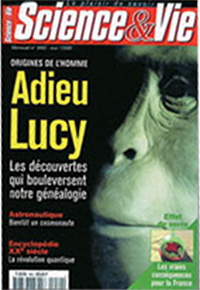 |
| Farewell Lucy |
The world famous paleoanthropologist Richard Leakey also says that Lucy has no evolutionary validity: It is overwhelmingly likely that Lucy (Australophitecus afarensis) was no more than a variety of pygmy chimpanzee. The evidence for the alleged transformation from ape to man is extremely unconvincing.68
In addition, as a result of his researches into Australopithecines the evolutionist Lord Zuckerman also concluded that they were an ordinary species of ape and very definitely did not walk upright.69
Another evolutionist and anatomist well known for his research into the subject, Charles E. Oxnard, stated that the skeletal structure of Australopithecines resembles that of today's orangutans.70
In 1994, Fred Spoor and his team from Liverpool University in Britain carried out a comprehensive study in order to arrive at a definitive conclusion regarding the Australopithecus skeleton. An organ in the skeleton known as the "cochlea," which determines the position of the body in relation to the ground, was investigated. Spoor's conclusion was that Australopithecus did not walk in a bipedal manner similar to that of human beings.71
Another study in 2000 by the scientists B.G Richmond and D.S Strait, published in Nature magazine, examined the forearms of Australopithecines. Their comparative anatomical research showed that the species had the same forearm structure as those of present-day monkeys that walk on four limbs.72
All this evidence reveals that Australopithecines were nothing more than species of ape. Indeed, the evolutionist anthropologists who discovered Lucy, Donald Johanson and T. D. White, issued the following statement in Science magazine:
Fossils of Australopithecus have been studied in painstaking detail: their manner of walking, the structure of their ear, pattern of tooth development, their long and powerful forearms, short hind limbs, structure of their feet, small sized brains, and very ape- like skulls, jaws, and faces. These prove that Australopithecus was an ape and no way related to man. Donald Johanson himself, the discoverer of Lucy, later concluded that Australophitecus africanus (Lucy) was not related to humans at all.73
In summary, scientific research has refuted all the claims suggesting that Australopithecines were the forerunners of human beings. They were all species of apes, and to equate them with human beings is a scenario utilized by Darwinists for the sake of their fictitious and false theories.
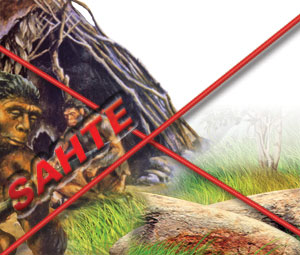  |
| For years, Neanderthals were depicted in false illustrations as supposed primitive ape-men. But science has shown that the Neanderthals are an extinct human race, and essentially no different to people living today. |
Darwinists employed the same technique they used with Australopithecus for the Neanderthals, an extinct human race.
Neanderthal Man entered the scientific literature with the discovery in 1856 of fossils in the Neander Valley near the German city of Düsseldorf. The curvatures in its skull and bones led it to being regarded by evolutionists as a supposed primitive human species.
In 1908, an almost complete skeleton described as belonging to Neanderthal Man was found in the French region of La Chapelle-aux-Saints. The bones were re-assembled by the famous paleontologist and geologist of the time, Marcellin Boule.
The Neanderthal Man that emerged from this re-assembly had a stooped posture and a protruding skull. Its legs were also locked at the joints, meaning it lacked a fully upright posture.
Through this appearance, the impression was formed in the minds of the people that Neanderthal Man was a primitive being. Neanderthals were also depicted as ape-men in fictitious illustrations.
This false impression of the Neanderthals lasted for 100 years. But analysis of the La Chapelle skeleton in the 1950s determined that the Neanderthal to whom it belonged had a kind of joint infection. Healthy individuals were in fact able to walk just like normal human beings.
In 1985, the same skeleton was examined by the anthropologist Erik Trinkhaus. That examination confirmed that Neanderthals walked upright and revealed another fact that had hitherto remained hidden: Marcellin Boule had deliberately portrayed Neanderthal as being stooped.74 The joint disorder identified in the 1950s was no obstacle to the individual walking upright. It appeared that the Darwinist Boule was unwilling to admit that the Neanderthal walked like a normal human being.
E. Trinkaus and W. W. Howells made the following statement in Scientific American magazine:
Today most scientists agree that Neanderthal Man stood fully upright and that in the absence of disease, its features are no different than modern humans.75
Meanwhile, the size of the Neanderthal skull also forced evolutionists into inconsistency. The reason was that Neanderthals had a skull volume of around 1700 cc; this is 200 cc more than the volume of today's human beings. The fact that Neanderthals, supposedly a "primitive" species, had a greater brain volume than Homo sapiens represented a huge contradiction for the theory of evolution.
The Neanderthal expert Erik Trinkhaus admits:
Detailed comparisons of Neanderthal skeletal remains with those of modern humans have shown that there is nothing in Neanderthal anatomy that conclusively indicates locomotor, manipulative, intellectual, or linguistic abilities inferior to those of modern humans.76
There is no doubt that because the Neanderthals were a human race they possessed the same features as modern races. Neanderthal Man was a talented maker of tools and a skilled hunter. He even engaged in music and art. They had a cultural and social structure, just like societies today, and had religious beliefs.77 The civilization established by the Neanderthals was therefore no different to present-day civilizations.
Neandertals: Stocky Human Beings | |
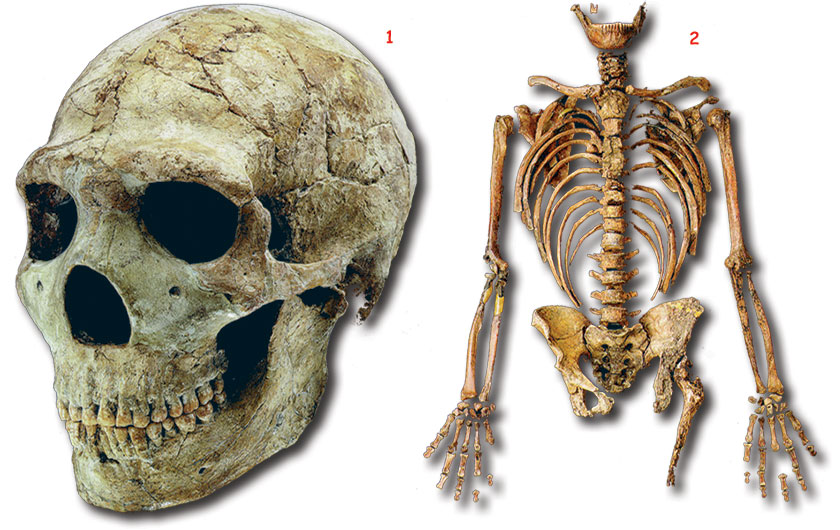 | |
| 1. Homo sapiens neanderthalensis, Amud 1 skull | 2. Neanderthal remains |
| Above, The Homo sapiens neanderthalensis Amud 1 skull found in Israel. The individual is estimated to have been 1.80 m tall. The cranial capacity is the largest found to date: 1740 ccs. This fossil therefore explicitly refutes the claims to the effect that the Neanderthals were a primitive species. The Kebara 2 (Moshe) fossil to the side is the best preserved Neanderthal remains to date. It is impossible to distinguish the skeletal structure of this 1.70 meter tall fossil from that of modern man It appears from the remains of tools discovered together with the fossil that the society to which this individual belonged shared the same culture as contemporary Homo sapiens communities. | |
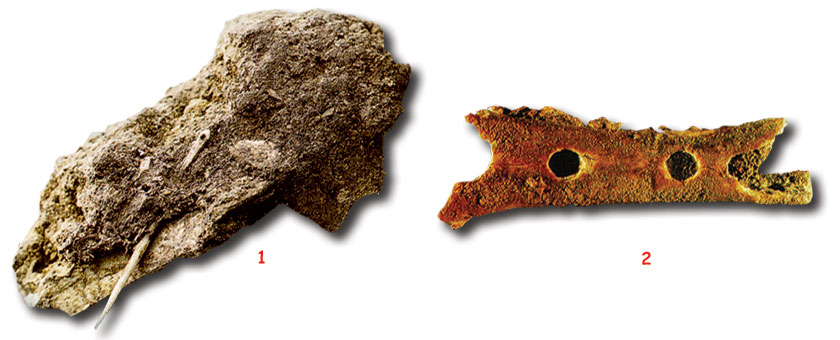 | |
| 1. Sewing Needle | 2. Whistle |
| For years, Darwinists depicted the Neanderthals as ape-like ancestors of man. Yet these tools from the time show that the Neanderthals had the same conception of art and beauty as modern man. Neanderthals are simply an extinct race of human beings. The only rason for these efforts to use them as evidence for evolution is that they are extinct. | |
A further issue regarding Neanderthals that represents an insuperable dilemma for Darwinists is the problem of dating. Fossils discovered show that Neanderthals were living at the same time as modern human beings and that in some circumstances they were even living much later. Evolutionist biologist Francisco J. Ayala from the University of California admits:
A few years ago, they [Neanderthals] were thought to be ancestral to anatomically modern humans, but now we know that modern humans appeared at least 100,000 years ago, much before the disappearance of the Neanderthals. Moreover, in caves in the Middle East, fossils of modern humans have been found dated 120,000-100,000 years ago, as well as Neanderthals dated at 60,000 and 70,000 years ago, followed again by modern humans dated at 40,000 years ago. It is unclear whether the two forms repeatedly replaced one another by migration from other regions, or whether they coexisted in some areas.78
The Neanderthals, proposed as a so-called ape-like ancestor of man, are therefore actually an extinct human race. In the same way that modern-day humans possess different features unique to their own races, so the Neanderthals also had their own unique characteristics. Therefore, it is a huge deception to use them as evidence for evolution. Indeed, the Neanderthal fossil was removed from the scientific literature in 1978. But the Neanderthals still appear in Darwinist references as if they represent some great evidence of evolution.
The aim behind the speculation about Neanderthal Man that is still going on in some evolutionist publications is to influence and mislead people who are ignorant of the true facts about the Neanderthals, and who are unaware that they were a "transitional form" that has been scientifically discredited. It is therefore of the greatest importance to highlight the true facts about Australopithecus and the Neanderthals, and to put an end to this Darwinist deception.
In 1912, Charles Dawson, a well-known doctor and also an amateur paleontologist, claimed to have found a jaw bone and skull fragment in a depression near Piltdown, England. Although the jaw bone resembled an ape jaw, the teeth and skull resembled those of a human being. The fossils were given the name "Piltdown Man," dated at 500,000 years old, and put on display in the British Museum as the most significant evidence of so-called human evolution. A great many scientific papers, analyses and illustrations were produced over the next 40 years. Some 500 academics from different universities wrote doctoral theses about Piltdown Man.79
On a visit to the British Museum in 1935, the well-known American paleoanthropologist H. F. Osborn said, "... Nature is full of paradoxes... a discovery of transcendent importance to the prehistory of man."80
But Piltdown Man was a huge fraud, a deliberately manufactured hoax.
In 1949, Kenneth Oakley from the British Museum Paleontology Department sought permission to use the newly developed "fluoride test" on a number of ancient fossils. The Piltdown Man fossil was duly tested using the technique. The test revealed that there was no fluoride in the Piltdown Man jaw bone. This meant that the jaw bone had been underground for no more than a few years. The skull itself contained a small amount of fluoride and must have been a few thousand years old.
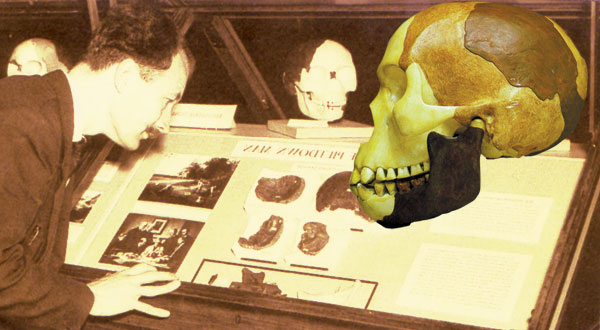 |
| 1. The Fake Piltdown Man Skull |
| The Piltdown Man is an infamous hoax, assembled by adding a human skull to the jaw of a recently deceased orangutan. This hoax fossil was displayed for some 40 years in the British Museum as proof of the supposed evolution of man. When the fraud was exposed, in 1949, it was hurriedly removed from both the museum and the scientific literature. However, this fossil has been immortalized in the history books as a source of enormous shame for Darwinists. |
Subsequent chronological research based on the fluoride technique revealed that the skull was no more than a few thousand years in age. It was also realized that the teeth in the jaw bone had been artificially worn down, and that the primitive tools found beside the fossils were replicas carved out using steel equipment.81 Oxford professor of physical anthropology Joseph Weiner's detailed analyses definitively confirmed this fraud in 1953. The skull was human, around 500 years old, while the jaw bone belonged to a recently deceased orangutan! The teeth had been added on and set afterwards to give the impression of being human, and the insertion points had been planed down. All the fragments had then been stained with potassium dichromate in order to give an aged appearance. This staining disappeared when the bones were placed in acid. Le Gros Clark, from the team that exposed the hoax, was unable to conceal his amazement and said: "The evidences of artificial abrasion immediately sprang to the eye. Indeed so obvious did they seem it may well be asked-how was it that they had escaped notice before?" 82
The science writer Hank Hanegraaff referred to this astonishing state of affairs as follows: "... as Marvin Lubenov explains, 'The file marks on the orangutan teeth of the lower jaw were clearly visible. The molars were misaligned and filed at two different angles. The canine tooth had been filed down so far that the pulp cavity had been exposed and then plugged.'"83
The evolutionist biologist Keith Steward Thomson made this comment about the Piltdown Man lie, "The Piltdown man forgery of 1912 was one of most successful and wicked of all scientific frauds."84
Following this surprising and, for Darwinists, embarrassing discovery, Piltdown Man was hastily removed from the British Museum where it had been on display for some 40 years. The Darwinist deception was so enormous that a hand-made fossil had fooled the whole scientific world and all mankind for 40 years. This would inevitably go down as one of the blackest marks in the history of evolution. Professor of Anthropology Pat Shipman described the impact of this fraud: "The Piltdown fossils, whose discovery was first announced in 1912, fooled many of the greatest minds in paleoanthropology until 1953, when the remains were revealed as planted, altered – a forgery."85
The journalist, writer and philosopher Malcolm Muggeridge described the position that Darwinism, propped up by hoaxes such as Piltdown Man, had placed all humanity in as follows: "I myself am convinced that the theory of evolution, especially the extent to which it's been applied, will be one of the great jokes in the history books in the future. Posterity will marvel that so very flimsy and dubious an hypothesis could be accepted with the incredible credulity that it has."86
The Piltdown hoax, committed, at least in the perpetrators' eyes, in order to eliminate belief in Creation and to convince people of the lie that human beings came into existence spontaneously and with no responsibilities, is actually a stratagem of atheistic freemasonry, which is the system of the antichrist. But Allah's glorious creation and matchless works are so apparent and manifest that with today's science there is nowhere they cannot be seen. These vain endeavors across the world on the part of the antichrist just humiliate him and his followers, and clearly reveal the failure of the Darwinism lie. Allah, our Almighty Lord, has told us in numerous verses of the Qur'an, how He created human beings, and every piece of evidence in the universe clearly reveals this sublime creation:
He Who has created all things in the best possible way. He commenced the creation of man from clay; then produced his seed from an extract of base fluid; then formed him and breathed His Spirit into him and gave you hearing, sight and hearts. What little thanks you show! (Surat as-Sajda, 7-9)
In 1922, American Museum of Natural History director Henry Fairfield Osborn announced that he had discovered a Pliocene molar tooth fossil near Snake Valley in West Nebraska. This tooth, it was claimed, bore common ape and human features. Before long, a profound scientific debate had commenced on the subject. Some interpreted this tooth as coming from Pithecanthropus erectus while others said it was more human. This fossil that created such major debates was given the name "Nebraska Man." A "scientific" name followed immediately after: Hesperopithecus haroldcooki.
Reconstructions of Nebraska Man's skull and body were produced on the basis of this single tooth. Things went even further as pictures showing Nebraska Man's family in their natural habitat were published. All these scenarios were produced from just one tooth. Evolutionist circles adopted this "ghost man" so strongly that when a researcher called William Bryan opposed such definitive pronouncements being made on the basis of a single molar, he attracted enormous wrath.
In 1927, however, other parts of the skeleton were found. These showed that the tooth belonged neither to a human being nor to an ape or monkey. It was realized that the tooth belonged to a species of extinct American wild pig called Prosthennops. William Gregory titled a paper in Science magazine in which he announced this "Hesperopithecus: Apparently Not an Ape Nor a Man."87
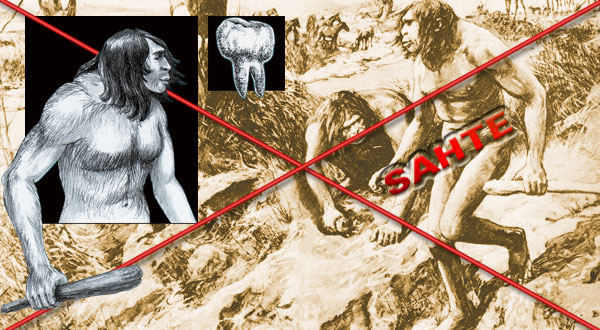  |
| Darwinists produced false pictures of Nebraska Man together with his family, all on the basis of a single pig tooth, and published these in text books. For many years, they had no compunction about deceiving students and other people. |
Science writer Hank Hanegraaff explains the developments as follows:
In 1922, A TOOTH WAS DISCOVERED IN NEBRASKA. With a little imagination the tooth was connected to a mythological jawbone, the jawbone was connected to a skull, the skull was connected to a skeleton, and the skeleton was given a face, features, and fur. By the time the story hit a London newspaper, not only was there a picture of "Nebraska Man" but there was also a picture of "Nebraska Mom." All of that from a single, solitary tooth. Imagine what might have happened if a skeleton had been discovered. Perhaps a yearbook would have been published!
Sometime after the initial discovery, an identical tooth was found by geologist Harold Cook. This time the tooth was attached to an actual skull, and the skull was attached to the skeleton of a wild pig. Thus, Nebraska man, known by the "scientific" designation Hesperopithecus haroldcooki, has been unmasked as a myth rather than a man in the making.88
As a consequence, all pictures of Hesperopithecus haroldcooki and its "family" were hastily removed from the literature. Nebraska Man is an important indication of how Darwinists can produce an utterly fantastic scenario of evolution on the basis of a single tooth. Although a tooth provides no information about a living thing's general anatomy, the way that the drawings of Nebraska Man and his family were produced on the basis of a pig's tooth, and the fact that this was portrayed as scientific until the truth was revealed, is a huge logical deficiency and an utter humiliation for Darwinism. But Darwinists have refused to abandon frauds, and are consciously continuing with their Darwinist deceptions.
Tree bark in the mid-19th Century during the early part of the Industrial Revolution in Great Britain was light in color. For that reason, dark colored variants of the moth species (melanic moths) Biston betularia could easily be seen and caught by birds. Fifty years later, however, lichens, a kind of algae, had died out around the trees as a result of industrial pollution, and the trees had become darker in color. At this time, it was now the lighter colored moths that were more visible on the trees and that were caught more often by birds. As a result, the number of light colored moths declined, while the darker melanic moths increased in number, since these were less easily caught.
Evolutionists eagerly seized on this state of affairs as significant evidence for their claims of evolution by way of natural selection. Using the same deceptive techniques, as always, they then set about trying to mislead people into thinking that light-colored moths evolved into darker ones. This claim was heralded with the so-called phrase "evolution in action." But the facts were very different, since these moths in fact underwent no evolutionary change at all, the only thing present being a huge Darwinist deception.
In 1953, H.B.D. Kettlewell, a Darwinist doctor of medicine and also an amateur biologist, decided to perform an experiment to observe the phenomenon. He carried out experiments and observations in rural parts of England where these moths were living. As a result of his experiments, Kettlewell determined that dark moths on lighter lichen were caught in larger numbers. He then announced this in an article titled "Darwin's Missing Evidence" in Scientific American magazine, as if this were a giant discovery in the name of Darwinism. By 1960, Kettlewell's account had assumed its place in all school text books.
 |
| A result of industrial pollution the lichens, a kind of moss, covering tree trunks die and the trunk turn black. Since light-colored moths are more visible on these trunks they are more often eaten by birds. Therefore, as the number of light-colored moths declines, the numbers of dark-colored ones rises, as they are eaten less frequently. But there being large numbers of one kind of moth is most definitely not evolution; yet Darwinists use this to mislead people and try to depict it as supposed evidence for evolution. |
In 1985, certain peculiarities began to be noticed. A young American biology teacher called Craig Holdrege came across an interesting statement in the notes of Sir Cyril Clarke, a close friend of Kettlewell and who took part in his experiments. Clarke said:
All we have observed is where the moths do not spend the day. In 25 years, we have only found two betularia on the tree trunks or walls adjacent to our traps...89
Holdrege had for a long time been showing his students photographs of moths placed on tree trunks and describing how birds would locate and catch the more visible ones. But now someone who had researched these moths for 25 years was saying he had only seen moths on the tree trunks twice. A fierce scientific debate erupted almost immediately. The debate led to the following conclusions: many studies performed after Kettlewell's experiments showed that the moths landed on only one kind of tree trunk, preferring the undersides of horizontal branches of all other kinds of tree. Since the 1980s, everyone has been in agreement that moths land only very, very rarely on tree trunks. Many scientists, such as Cyril Clarke and Rory Howlett, who conducted a 25-year study on the subject, as well as Michael Majerus, Tony Liebert and Paul Brakefield have declared that "Kettlewell obliged the moths to behave in an unnatural manner in his experiments, for which reason the results of the experiment are scientifically unacceptable."
Researchers investigating Kettlewell's experiment encountered an even more astonishing finding; while there should have been more light-colored moths in unpolluted regions of England there were actually four times as many dark ones. In other words, contrary to what Kettlewell claimed, and what had been reiterated in every evolutionist reference book, there was no correlation between tree bark and the ratios in the moth population.
The American lepidopterist (an expert engaged in scientific study of butterflies and moths) Ted Sargent and other researchers noted that the moths in question did not land on the tree trunks but hid beneath the upper branches. In addition, the moths slept in the day and flew about at night; in other words, when the birds were asleep!90
The more the matter was investigated, the greater the scale of the scandal: the "moths on tree bark" photographed by Kettlewell were actually dead. Since moths settle on the under sides of the branches rather than on the tree trunk, there was effectively no means of obtaining such an image. For that reason, Kettlewell stuck these dead animals to the trees with glue and then photographed them.91
The New York Times made this comment when it was realized that the moths that Darwinists had so loudly portrayed as scientific evidence for around a century were in fact fraudulent: "The most famous example of evolution in action must now become the most infamous"92
When The University of Chicago evolutionary biologist learned about this fraud in 1998, he wrote of his "shame" due to the Industrial Revolution moths he had been teaching his students about for years being a hoax, and compared his reaction to "the dismay attending my discovery, at age 6, that it was my father and not Santa who brought the presents on Christmas Eve."93
With the revelation of all these facts, people realized that the tale of the Industrial revolution moths, depicted as "Darwin's missing evidence," was in fact a giant deception. For decades hundreds of millions of people had been deceived by photographs of a few dead moths glued onto a tree and a hoary old tale concerning them. The real truth of the matter is this: the evidence that Darwin needed does not exist and it is impossible for it ever to be found. Because living things did not evolve.
The interesting thing is that the Industrial Revolution moths are still presented in some text books as evidence of evolution. In this way, Darwinists aim to mislead impressionable young minds that are unaware of this fraud. Depicting a fraud as genuine evidence, even though this fraud has already been exposed, is in fact evidence of Darwinism's despair, lack of proof and purely ideological nature. The fact of Creation is clear to see. Darwinists trying to avoid this clear fact imagine they can find a solution by resorting to lies and trickery. But Allah will certainly do away with trickery and falsehood and superstitious religions.
Say, "Truth has come and falsehood has vanished. Falsehood is always bound to vanish." (Surat al-Isra', 81)
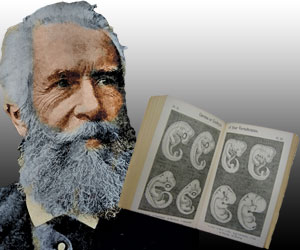 |
| Ernst Haeckel and his false embryo drawings. |
In his 1868 book Natürliche Schöpfungsgeschichte (The History of Natural Creation) Ernst Haeckel suggested that he had made various comparisons using human, monkey and dog embryos. The drawings he produced consisted of nearly identical embryos. On the basis of these drawings, Haeckel then suggested that the life forms involved had common origins.
But the true state of affairs was very different. Haeckel had produced a drawing of just a single embryo, and then produced human, monkey and dog embryos from this by making very small changes. In other words, it was a hoax.
That was the supposed "scientific work" (!) that Darwin cited as a reference in his book The Descent of Man. In fact, some people realized that Haeckel's illustrations were a distortion even before Darwin wrote his book. Following the exposure of the fraud, Haeckel himself admitted the huge scientific fraud he had perpetrated:
After this compromising confession of 'forgery' I should be obliged to consider myself condemned and annihilated if I had not the consolation of seeing side by side with me in the prisoner's dock hundreds of fellow - culprits, among them many of the most trusted observers and most esteemed biologists. The great majority of all the diagrams in the best biological textbooks, treatises and journals would incur in the same degree the charge of 'forgery,' for all of them are inexact, and are more or less doctored, schematised and constructed.94
But according to Darwinists, in order to keep the dogma of Darwinism propped up, there was a need to declare that one of the false pieces of evidence in their possession was actually "proof of evolution." The fraud perpetrated, or other Darwinists being aware of it, was unimportant for them; what mattered in their eyes was for it to be heralded as evidence of evolution, even if it was fraudulent.
That is the reason why, despite the exposure of the fraud, Darwin and the biologists who supported him continued to regard Haeckel's drawings as a reference source. And that further encouraged Haeckel. In the years that followed he produced further series of comparative embryo illustrations. He prepared diagrams showing fish, salamander, turtle, chicken, rabbit and human embryos side by side. The noteworthy aspect of these was how the embryos of these different life forms initially resembled one another very closely and gradually diverged over the course of their development. The similarity between the human and fish embryos in particular was very striking indeed. So much so that fictitious "gills" could be seen in the human embryo drawings, just as in those of the fish. Under the scientific guise he gave these illustrations, Haeckel launched his "theory of recapitulation": Ontology Repeats Phylogeny. The meaning of the slogan was this; according to Haeckel, during the developmental process it undergoes in the egg or the mother's womb, every living thing repeats the supposed "evolutionary history" of its species, right from the very beginning. According to this false theory, the human embryo in the mother's womb first resembles a fish and then, in subsequent weeks, a salamander, a reptile and a mammal, finally "evolving" into a human being.
But this was a huge fraud.
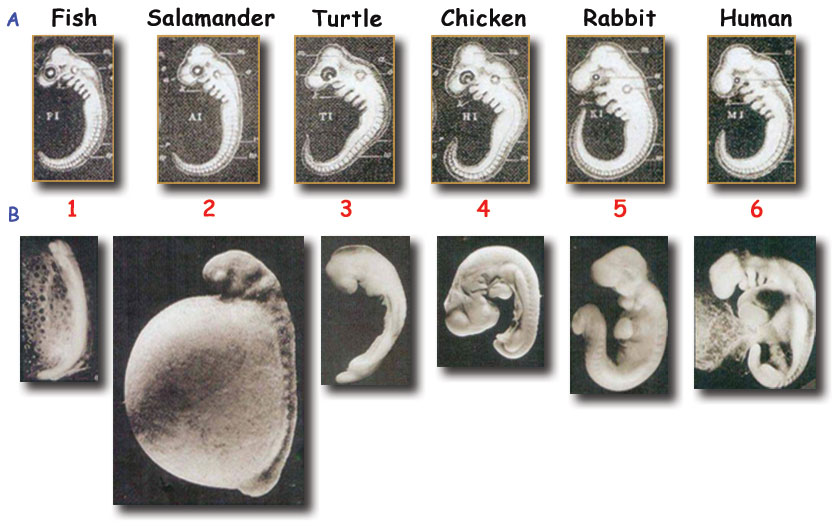 | |
| 1. Fish | 4. Chicken |
| A. Above, Haeckel's false drawings | B. Below, how the drawings should have looked |
In the 1990s the British embryologist Michael Richardson examined vertebrate embryos under the microscope and determined no resemblance to Haeckel's drawings. Following their study, Richardson and his team published genuine photographs of embryos in the August 1997 issue of the journal Anatomy and Embryology. It appeared that Haeckel had taken various template designs and distorted them in various ways so that the embryos would resemble one another. He added imaginary organs to embryos, removed organs from others, and depicted embryos of very different sizes as being the same in scale. The clefts that Haeckel depicted as "gills" in the human embryo had in fact nothing to do with gills at all. They were actually the middle ear canal and the beginnings of the parathyroid and thymus glands. The embryos did not in fact resemble one another whatsoever . Haeckel had made innumerable distortions in his illustrations.
An article about Haeckel's drawings, for long maintained on the agenda as false evidence of evolution, appeared in the September 5, 1997, issue of Science magazine titled "Haeckel's Embryos: Fraud Rediscovered," following which the whole scientific world agreed that there had been a fraud perpetrated. The article contained the following lines:
Not only did Haeckel add or omit features, Richardson and his colleagues report, but he also fudged the scale to exaggerate similarities among species, even when there were 10-fold differences in size. Haeckel further blurred differences by neglecting to name the species in most cases, as if one representative was accurate for an entire group of animals. In reality, Richardson and his colleagues note, even closely related embryos such as those of fish vary quite a bit in their appearance and developmental pathway. "It (Haeckel's drawings) looks like it's turning out to be one of the most famous fakes in biology,"95
In March 2000 Harvard University evolutionist and paleontologist Stephen Jay Gould said that he had long been aware of this fraud but he had preferred to remain silent, as required by the system of the dajjal.96 Once the public had learned that the drawings were fraudulent, Gould stated that it was academic murder for them still to be used and said: "We do, I think, have the right, to be both astonished and ashamed by the century of mindless recycling that has led to the persistence of these drawings in a large number, if not a majority, of modern textbooks."97
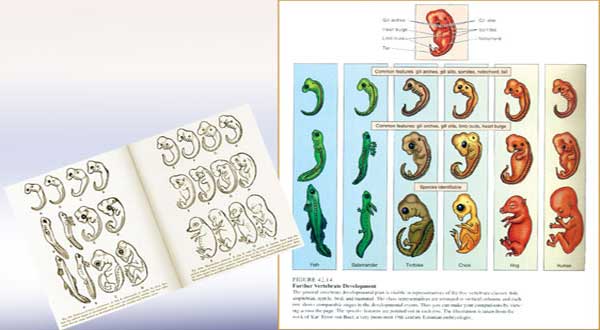 |
| The modern-day biology book to the left engages in false evolutionary propaganda by using Haeckel's fake drawings. This is important evidence of how broadly and shamelessly the Darwinist deception is perpetrated. |
Haeckel's fraud was so blatant and so great that he was accused of fraud by five different professors and found guilty by the Jena University court.98
Sir Gavin de Beer, from Great Britain's Natural History Museum, described this terrible disgrace as follows:
Seldom has an assertion like that of Haeckel's 'theory of recapitulation,' facile, tidy, and plausible, widely accepted without critical examination, done so much harm to science."99
These false illustrations of Haeckel's in fact achieved their intended aim on behalf of Darwinists. Although they had been declared to be false, they still had a negative impact as a great many people still imagined them to be genuine, and despite their scientific invalidity they still negatively altered the general views regarding living things of people still undergoing education in schools. Henry M. Morris, founder of the Creation Research Society and the Institute of Creation Research analyzed the state of affairs in these terms:
Ever since Darwin—and especially since Freud—psychologists have assumed that man is merely an evolved animal and have evaluated his behavioral problems on an animalistic basis. Experiments with monkeys or other animals (even with insects) are used for guidance in dealing with human problems...
The bitter fruit of the recapitulation theory (long since discredited scientifically) continued to grow in many areas of society...100
Amazingly enough, Haeckel's fraudulent illustrations, described as a scientific disgrace and treated with amazement even by some evolutionists when put forward as evidence, still maintain their place in various text books. This astonishing state of affairs shows the exact scale of the Darwinist deception. University of California molecular biologist Jonathan Wells describes the situation thus:
Many textbooks use slightly redrawn versions of Haeckel's embryos. One example is the 1999 edition of Peter Raven and George Johnson's Biology …
Other examples include the 1998 edition of Cecie Starr and Ralph Taggart's Biology: the Unity and Diversity of Life, … the latest edition of James Gould and William Keeton's Biological Science, which reports: "One fact of embryology that pushed Darwin toward the idea of evolution is that the early embryos of most vertebrates closely resemble one another;" and Burton Guttman's 1999 textbook, Biology, which accompanies its redrawn version of Haeckel's embryos with the following: "An animal's embryonic development holds clues to the forms of its ancestors."101
The fact that Haeckel's false illustrations are still used in biology text books, as if they represented proof of evolution, is without doubt no simple error. Despite being forgeries, these illustrations are deliberately included in text books. The main reason for this, without doubt is that they represent significant false evidence for the key point of Darwinism, the falsehood that man is an irresponsible animal. Jonathan Wells makes this comment about this lie deliberately maintained by Darwinist scientists:
Haeckel's embryos seem to provide such powerful evidence for Darwin's theory that some version of them can be found in almost every modern textbook dealing with evolution. Yet biologists have known for over a century that Haeckel faked his drawings; vertebrate embryos never look as similar as he made them out to be. Furthermore, the stage Haeckel labeled the "first" is actually midway through development; the similarities he exaggerated are preceded by striking differences in earlier stages of development. Although you might never know it from reading biology textbooks, Darwin's "strongest single class of facts" is a classic example of how evidence can be twisted to fit a theory.102
Although Darwinists were delighted in the short term that a lie planned by the dajjal was put forward as false evidence for a heretical theory and had such an impact, it in fact heralded terrible disappointment for them. Through Haeckel's drawings, people saw the scale of the deception to which a senior scientist would resort to in the name of Darwinism. It was thus once again proved how Darwinism was in constant need of a "lie." People clearly saw how evolutionists could turn a blind eye to fraud. Haeckel's fraud was another significant piece of evidence of the destruction of the theory of evolution and the system of the dajjal. This fraud may have been met with silence in the 20th Century, but the 21st Century has seen this and similar frauds exposed, and the genuine scientific evidence put on display. The more these frauds have been exposed, and the more genuine scientific evidence produced, the more the collapse of Darwinism has become ever more apparent.
In 1879, two well-known evolutionists of the time went even further in their activities intended to constitute evidence for the fictitious evolution of the horse scenario, and set up the equine series that Darwinists would maintain on the agenda for many years to come. The American fossil researcher Othniel Charles Marsh and Thomas Huxley (known as "Darwin's bulldog") established a supposed equine evolutionary series by setting out various hoofed fossils, based on the number of nails on the front and rear feet and the structure of their teeth. One small mammal fossil, previously named Hyracotherium by Sir Richard Owen in 1841, was renamed in such a way as to echo so-called evolution, being given the name Eohippus, meaning "Dawn Horse." The pair published their claims and diagrams in the American Journal of Science, thus laying the foundations for the horses' evolutionary sequence laid out from Eohippus to the present day in museums and text books as supposed evidence of evolution. The main stages in this fictitious series were Eohippus, Orohippus, Miohippus, Hipparion and the present-day Equus.
This fictitious sequence was portrayed as the greatest supposed evidence for the evolution of the horse for the following century. The decrease in the number of toes and the regular increase in size, from smaller to larger, was enough to convince evolutionists.
Shortly afterwards, inconsistencies within the evolutionary sequence began manifesting themselves. New fossils were unearthed, and attempts to insert these into the false sequence presented a problem. The trouble was that characteristics such as the fossils' location, age and toe number formed inconsistencies and impaired the series, which turned into an inconsistent and meaningless mass of fossils in the face of these new specimens.
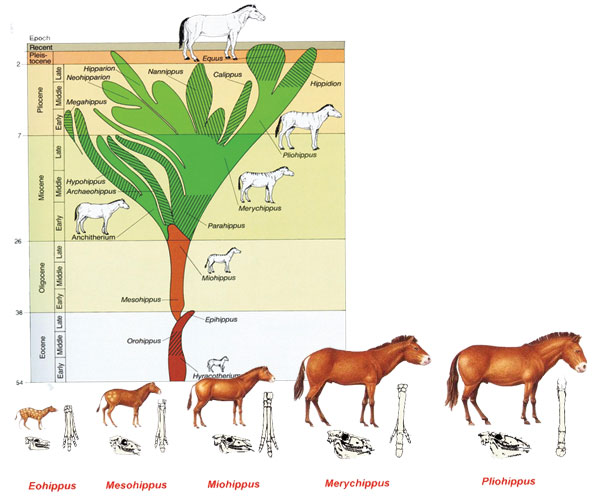  |
Many Darwinists were gradually forced to admit that the Darwinist horse evolutionary sequence scenario was not based on any genuine evidence. In November 1980, a 4-day conference was held in the Chicago Museum of Natural History, which was attended by 150 evolutionists, and considered the problems facing the theory of evolution. Boyce Rensberger, who spoke at the conference, described how the horse series had no basis in the fossil record and that no such gradual process as the evolution of the horse ever happened:
The popularly told example of horse evolution, suggesting a gradual sequence of changes from four-toed fox-sized creatures living nearly 50 million years ago to today's much larger one-toed horse, has long been known to be wrong. Instead of gradual change, fossils of each intermediate species appear fully distinct, persist unchanged, and then become extinct. Transitional forms are unknown.103
Another problem in the fictitious evolution of the horse is that of dating. Doctor Nicholas Comninellis comments:
An additional challenge to the proposal of horse evolution is that the timing is inconsistent. The theory of evolution is based on the concept that one species is prone to evolve into another because it is better adapted for survival. This leads to extinction of the first species. In the case of horses, the three-toed must not have been as hearty as the one-toed. Evolution demands millions of years for transition to occur between species— plenty of time for the first species to die out.
However, today we know that the three-toed and one-toed horses lived together in North America. The fact that varieties of horses co-existed is completely inconsistent with evolution's explanation. Add to this the fact that missing links between Hyracotherium, Miohippus, and Equus have never been identified. Rather than lending support for evolution, the history of the horse is more consistent with special creation—fully formed beings that were created simultaneously.104
Although the invalidity of the evolution of the horse has been brought out into the open day and Darwinists have admitted this state of affairs, this mythical sequence is still used, like other Darwinist frauds, in Darwinist publications and text books. The evolutionary series is depicted as concrete fact and placed on display in museums of natural history curated by world-famous paleontologists and scientists. Dr. Niles Eldredge, an evolutionist paleontologist and the director of the world-renowned American Museum of Natural History, admitted some 20 years ago that evolutionist claims regarding the horse series on display in his own museum were based solely upon their powers of imagination. Eldredge also criticized the way that this speculative series was portrayed as scientific fact to such an extent as to find its way into school books:
I admit that an awful lot of that [imaginary stories] has gotten into the textbooks as though it were true. For instance, the most famous example on horse evolution prepared perhaps fifty years ago. That has been presented as literal truth in textbook after textbook. Now I think that is lamentable, particularly because the people who propose these kinds of stories themselves may be aware of the speculative nature of some of the stuff. But by the time it filters down to the textbooks, we've got science as truth and we've got a problem.105
The Darwinist Eldredge's analysis is a most accurate one. Since deliberate distortions represent the essence of the system of the dajjal, those who espouse this system resort to deceptions too. All the examples of Darwinist deception listed above have been exposed, and their false nature has even been admitted to by Darwinist scientists. These examples are sufficient to show the true face of the system of the dajjal. But it will still be useful to issue the following reminder: the Theory of Evolution, Darwinist ideology in other words, is built on a lie intended to deny the existence of Allah. Therefore, all the claims, suggestions and evidence produced by Darwinism are false. All the statements to the effect that "proof of evidence has been discovered," "living things evolved," "or "human beings and chimpanzees are descended from a common ancestor" are lies. Darwinists espouse a lie. Their illogical obedience and devotion to the system of the dajjal is blind devotion to the religion of Darwinism, solely in order to be able to oppose belief in Allah.
The fact is that they espouse a superstition, a terrible error. Almighty Allah, the Lord and Creator of All, says in His verses:
If anyone desires anything other than Islam as a religion, it will not be accepted from him, and in the Hereafter he will be among the losers. (Surah Al 'Imran, 85)
Everyone in the heavens and everyone on the earth belong to Allah. Those who call on something other than Allah are not really following their partner-gods. They are only following conjecture. They are only guessing. (Surah Yunus, 66)
67. Isabelle Bourdial, "Adieu Lucy", Science et Vie, Mayıs 1999, no. 980, s. 52-62 
68. Richard Leakey, "Lucy - Evolution's Solitary Claim For an Ape/Man: Her Position is Splitting Away" Creation Research Society Quarterly, vol. 22, no. 3, Aralık 1985, s. 144-145 - Nicholas Comninellis, Creative Defense, Evidence Against Evolution, Master Books, 2001, s. 188 
69. Solly Zuckerman, Beyond The Ivory Tower, New York: Toplinger Publications, 1970, s. 75-94 
70. Charles E. Oxnard, "The Place of Australopithecines in Human Evolution: Grounds for Doubt", Nature, cilt 258, s. 389 
71. Fred Spoor, Bernard Wood, Frans Zonneveld, "Implication of Early Hominid Labryntine Morphology for Evolution of Human Bipedal Locomotion", Nature, cilt 369, 23 Haziran 1994, s. 645-648 
72. Richmond, B.G. and Strait, D.S., Evidence that humans evolved from a knuckle-walking ancestor, Nature 404(6776):382, 2000.) 
73. D. Johanson - T. D. White, Science, 203:321, 1979, 207:1104, 1980 - Nicholas Comninellis, Creative Defense, Evidence Against Evolution, Master Books, 2001, s. 187-188 
74. Trinkhaus, Erik (1985) Pathology and the posture of the La Chappelle-aux-Saints Neanderthal. American Journal of Physical Anthropology Vol. 67 sf. 19-41. 
75. E. Trunkaus - W. W. Howells, Scientific American, 241(6):118 (1979) - Nicholas Comninellis, Creative Defense, Evidence Against Evolution, Master Books, 2001, s. 195 
76. Erik Trinkaus, "Hard Times Among the Neanderthals", Natural History, cilt 87, Aralık 1978, s. 10. 
77. Nicholas Comninellis, Creative Defense, Evidence Against Evolution, Master Books, 2001, s. 194 
78. Francisco J. Ayala, Darwin and Intelligent Design, Fortress Press, Minneapolis, 2006, s.45 
79. Malcolm Muggeridge, The End of Christendom, Grand Rapids, Eerdmans, 1980, s. 59 
80. Stephen Jay Gould, "Smith Woodward's Folly", New Scientist, April 5, 1979, s. 44 
81. Kenneth Oakley, William Le Gros Clark & J. S, "Piltdown", Meydan Larousse, cilt 10, s. 133. 
82. Stephen Jay Gould, "Smith Woodward's Folly", New Scientist, April 5, 1979, s. 44 
83. Hank Hanegraaff, Fatal Flaws "What Evolutionists Don't Want You To Know", W Publishing Group, 2003 s. 34 
84. Keith Steward Thomson, "Piltdown Man: The Great English Mystery Story", American Scientist, vol. 79, 1991, s. 194 - Nicholas Comninellis, Creative Defense, Evidence Against Evolution, Master Books, 2001, s. 197 
85. Pat Shipman, "On the Trail of the Piltdown Freudsters" New Scientist, vol. 128, 1990, s. 52 - Nicholas Comninellis, Creative Defense, Evidence Against Evolution, Master Books, 2001, s. 197 
86. Malcolm Muggeridge, The End of Christendom, Grand Rapids MI, Eerdmans, 1980, s. 59 - Nicholas Comninellis, Creative Defense, Evidence Against Evolution, Master Books, 2001, s. 253-254 
87. W. K. Gregory, "Hesperopithecus Apparently Not An Ape Nor A Man", Science, vol. 66, December 1927, s. 579 
88. Hank Hanegraaff, Fatal Flaws "What Evolutionists Don't Want You To Know", W Publishing Group, 2003 s. 31-32 
89. Judith Hooper, Of Moths and Men, W.W. Norton & Company, Inc., New York, 2002, s.xvii 
90. Ann Coulter, Godless: The Church of Liberalism, Crown Forum Publishing, 2006, s. 236-237 
91. Judith Hooper, Of Moths and Men, s. xviii 
92. Ann Coulter, Godless: The Church of Liberalism, Crown Forum Publishing, 2006, s. 237 
93.http://www.arn.org/docs/richards/jr_sciedreport.htm - Jonathan Wells, Evrimin İkonları, Gelenek yayınları, Ocak 2003, s. 150 
94. Francis Hitching, The Neck of the Giraffe: Where Darwin Went Wrong, New York: Ticknor and Fields 1982, s. 204 
95. Elizabeth Pennisi, Science, 5 Eylül 1997 
96. Ann Coulter, Godless: The Church of Liberalism, Crown Forum Publishing, 2006, s. 240 
97.http://www.arn.org/docs/richards/jr_sciedreport.htm 
98. Hank Hanegraaff, Fatal Flaws "What Evolutionists Don't Want You To Know", W Publishing Group, 2003, s. 70 
99. Hank Hanegraaff, Fatal Flaws "What Evolutionists Don't Want You To Know", W Publishing Group, 2003, S. 70 
100. Henry M. Morris, The Long War Against God, Master Books, 2000, s. 32 
101. Jonathan Wells, Evrimin İkonları, Gelenek yayınları, Ocak 2003, s. 103 
102. Jonathan Wells, Evrimin İkonları, Gelenek yayınları, Ocak 2003, s. 86 
103. Boyce Rensberger, Houston Chronicle, 5 Kasım 1980, Bölüm 4, s. 15 
104. Nicholas Comninellis, Creative Defense, Evidence Against Evolution, Master Books, 2001, s. 168 